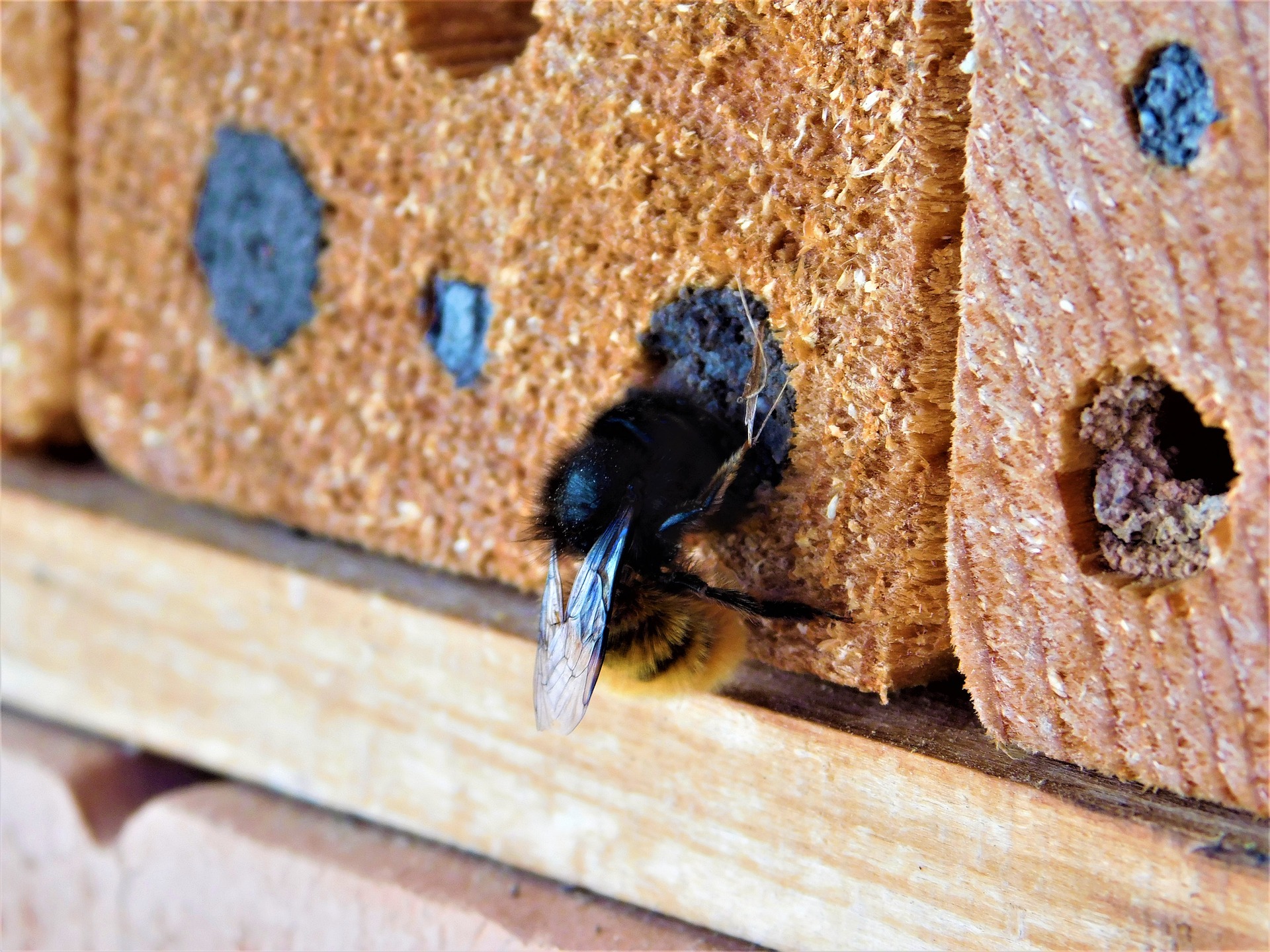Honeybees and other stinging insects are generally considered beneficial pollinators that are protected species in most states.
However, despite their mild manners, some stinging insects have a reputation for being aggressive and destructive.
While not as destructive as carpenter ants or termites, wood burrowing or carpenter bees in Pennsylvania can wreak havoc on your home, shed, swing set, or tree house.
Carpenter bees are attracted to softwoods, which fill the forests in Pennsylvania and are commonly found throughout the region, as far north as the Wyoming Valley and Poconos Mountains, all the way down to Montgomery County and the Lehigh Valley.
If you aren’t careful, these nuisance pests could cause some real cosmetic and structural damage to your home. Here are seven tips to get rid of carpenter bees in Pennsylvania and additional information to help you spot and identify an infestation.
What are Carpenter Bees?
As the name suggests, carpenter bees are part of the bee family; however, they are a bit of an outlier.
Unlike honeybees or bumblebees, carpenter bees are not social insects. Instead of living in colonies, they build individual nests in trees, the ground, and all sorts of outdoor wood, including anything on your home that fits the bill.
Coming in both large and small varieties, carpenter bees are attracted to unfinished or weathered wood. They will nest in door frames, decks, porches, or any area they find, destroying the surrounding wood in the process.
These insects also nest during winter inside these wooden structures and emerge again in the spring.
How to Identify Carpenter Bees
Carpenter bees often get mistaken for bumblebees because of their color. If you look closer, however, you can spot the difference.
While this type of bee has yellow markings on its body, they do not have any on its abdomen. Their abdomens are smooth, shiny, and black.
The bigger carpenter bees tend to grow between 12mm to 25mm long, and the smaller bees can reach about 8mm.
Why Carpenter Bees Are a Problem
Carpenter bees aren’t destructive on the same level as termites, but they can still be destructive.
These bees bore into unfinished or weathered wood and build nests, which can split and destroy the surrounding wood. While they occasionally attack stained and painted wood, they prefer bare wood over all else.
Again, while they aren’t as destructive as termites, they can cause a good deal of damage; both cosmetically and structurally. As they burrow deep into the wood, they will leave gaping holes and hollow out the inside.
This can cause the wood to decay faster. Plus, depending on how many are making homes on your property, it could affect structural integrity.
In addition, carpenter bees don’t just leave after winter. If they find a place with everything they need, they will return to roast in their little burrows again.
While male carpenter bees do not sting, females will, which can be painful. These bees do not sting very often but can get aggressive when their home is threatened.
Signs of Carpenter Bees
Carpenter bee infestations can often be identified with a few clear signs. These bees tend to target wood around your home, and while they might seem harmless at first, they can cause structural damage over time. Keep an eye out for the following indicators:
- Small holes in wood – Check all wooden areas around your home, including door and window frames, decks, porches, railings, and other exposed wood surfaces.
- Sawdust or pollen near holes – Look for a pile of sawdust (called frass) or a light dusting of pollen beneath or near the holes, which is a sign bees have been burrowing.
- Increased bee activity – Noticeable numbers of aggressive bees flying near wooden structures, especially males who guard the nests.
How to Get Rid of Carpenter Bees
Now that you’ve spotted the culprit and found where they are nesting, you can take steps to get rid of wood-burrowing bees for good. Depending on the size of the infestation, you may be able to handle it yourself.
However, if the issue is overwhelming, you may want to consider the help of a pest control expert. Here’s what you can do to find carpenter bees and keep them away from your home.
1. Seal Holes
If you happen to spot some holes in the wood around your home, you should plug them up. Use caulk or wood putty to put a stopper on any unwanted visitors. Remember, sealing these holes in the fall is a better idea as it will prevent carpenter bees from entering them in the spring. Otherwise, you may find a few more holes from bees trying to escape.
2. Check for Holes in Your Home
Remember, carpenter bees will reuse holes they’ve made in the past. As you check the exterior of your home for nests, do a double sweep to make sure that you’ve covered all your bases. They may burrow in unseen spots beneath windows or on wooden patio furniture as well.
3. Spray or Paint Unfinished Wood
While carpenter bees occasionally burrow into painted or stained wood, they prefer bare wood. Take the time to paint or stain any bare wood. However, if you like the unfinished look, consider getting the wood treated.
4. Use a Bee Spray
If you know where the bees are hovering and you’ve plugged up all the holes, you can try using a bee spray. Apply the spray on or around the holes to deter and kill these pests. In addition to taking care of the bee problem, some solutions will even kill the larvae.
Be cautious, though. Some pesticides can be dangerous to children and pets. Take the necessary steps for yourself when applying any type of pesticide, including wearing proper protective clothes, gloves, eyewear, and masks.
5. Bee Traps
If you want to avoid sprays, another way to stop carpenter bees is by using a bee trap. These traps will lure in bees and keep them from escaping.
The traps are small wooden boxes with ½ inch holes drilled into each side. At the bottom is an attached water bottle that you can screw off after the trap has worked its magic.
Bees will enter the wooden box in search of a place to nest. Unfortunately, once they fly inside, they are stuck in the plastic bottle and can’t get back out again.
Once the bees die, you can remove the bottle, empty the dead bees, and keep letting the trap do its thing. It’s an easy, hands-off, and chemical-free way of controlling the carpenter bees.
6. Replace Damaged or Rotten Wood
If you notice damaged wood in or around your property, consider having the wood patched or repaired. Advanced rotting wood, such as decaying trees or wooden fixtures, should be disposed of immediately as they will attract other pests, including termites.
7. Contact a Pest Control Expert
Don’t let carpenter bees burrow into your plans this spring and summer. Take the steps to fortify your home and stop them from damaging your property.
If you have an infestation that is more than you can handle or you aren’t sure if carpenter bees are the problem, feel free to contact a pest control expert for solutions.
The Pest Rangers offer monthly pest control plans that include barrier sprays and traps that help prevent a dozen common species of pests, including most stinging insects.
FAQs
Are carpenter bees dangerous?
Male carpenter bees can be aggressive but do not have stingers. Females can sting if provoked, but they are generally not aggressive unless directly disturbed.
What time of year are carpenter bees most active?
Carpenter bees are most active in spring and early summer, especially when they emerge to find nesting sites and mates.
Will carpenter bees damage my home?
Yes. Carpenter bees tunnel into wood to build nests, which can weaken structural wood over time, especially if they return year after year.





























